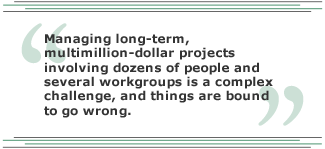The earth circles the sun, gravity makes things fall downward, and germs make you sick. Sure, that's all obvious now, but it took some very smart people a lot of time and effort to prove it. The same is true of management theories -- what seems perfectly obvious today is really just an assumption until someone tests and proves it.
 |
That's why Margaret Greenberg and Dana Arakawa have put the theory of positive leadership to the test. Greenberg is president of The Greenberg Group -- an executive coaching/consulting practice in Andover, Connecticut. Arakawa is a program associate at the John Templeton Foundation of West Conshohocken, Pennsylvania. Both are graduates of the Master of Applied Positive Psychology program at the University of Pennsylvania.
Greenberg and Arakawa wanted to know if managers who apply positive leadership practices have teams with higher project performance and employee engagement compared to teams led by managers who don't apply these practices. They surveyed more than 100 information technology professionals in different individual contributor and managerial roles at The Hanover Insurance Group last year. Greenberg and Arakawa published their findings in the paper, "Optimistic Managers and Their Influence on Productivity and Employee Engagement in a Technology Organization." What they discovered has applications for every business.
Positive behavior
In 2005, Jerry Krueger and Emily Killham reported on Gallup research that showed that supervisors play a crucial role in employee well-being and engagement. Engagement, in turn, has strong linkages to key business outcomes, including retention, productivity, profitability, customer engagement, and safety. (See "At Work, Feeling Good Matters" and "Feedback for Real" in the "See Also" area on this page.)
But the Gallup research that Krueger and Killham reported on didn't study what those managers did (their specific behaviors) to elicit positive responses from employees. That's what Greenberg and Arakawa wanted to investigate. They started the project with a few assumptions (based on a great deal of previous research) about positive leadership behavior: Positive managers use a strengths-based approach, maintain a positive perspective when difficulties arise, and provide frequent recognition and encouragement.
Why those three and no others? In part, it's because other studies have proven that those assumptions have a direct and salubrious effect on employees. Greenberg and Arakawa also chose those three variables because they're easily observable and testable behaviors.
But there's another reason: None of those characteristics are innate; they can all be learned. A few rare and precious individuals are born knowing how to work with people's strengths, give credit where it's due, and keep a game face when the going gets rough. Most of us weren't born knowing how to do these things, but we can be taught. A study on managerial behavior has limited usefulness if the results can't be applied to real people.
Working with strengths
There's a reason that a manager's focus on strengths or weaknesses is so important: Most organizations are obsessed with fixing weaknesses. That's why most companies conduct performance reviews, 360-degree assessments, and the like to evaluate how well employees and managers are measuring up to predefined goals and competencies. Such assessments, however, give cursory attention to an employee's strengths and instead focus almost exclusively on gaps or weaknesses; the assumption is that employees need to be good at many things rather than excellent in the key areas of their roles.
That's a negative view of human capital. Managers who take a strengths-based approach help employees identify strengths and align their talents with their work. These managers don't ignore employee weaknesses, but fixing them isn't their primary focus. Instead, positive managers focus more on what the employee is good at and how his or her strengths can be leveraged to the benefit of the employee, team, and organization.
Greenberg and Arakawa measured the degree to which managers used strength-based behaviors by asking employees to rate their level of agreement with a series of statements such as "My project manager matches my talents to the tasks that need to be accomplished" and "My project manager encourages high performance by building on my strengths." They found that managers who focused on strengths got much better performance from their teams than managers who focused on weaknesses.
Hanover already used a method to measure productivity, which the company called "project performance." This method includes how well projects meet budget, schedule, and quality standards. Using the employee responses, Greenberg and Arakawa ranked the extent to which managers focused on strengths and found that managers in the top quartile had much higher project performance results.
Looking at retrospective project performance results from 2005, managers in the top quartile achieved an average project performance score of 10.6 on a 20-point scale, while managers in the bottom quartile achieved an average score of 7.09. In 2006, the average score for top quartile managers was 17.91, compared to an average score of 11.55 for managers in the bottom quartile.
Good managers won't be surprised that there's a correlation between manager behavior and employee performance. But even Hanover's leaders were surprised by how much they correlate.
"The results helped to validate my beliefs and hypothesis that managers who maintain a positive perspective, who ensure that timely and meaningful recognition of people occurs, and who have a keen awareness of employees' strengths [help create] a more engaged workforce," says Greg Tranter, Hanover's senior vice president and CIO. "What surprised me about the outcomes was that the correlations were much stronger than I had anticipated."
In case you're wondering why the project performance results increased dramatically from 2005 to 2006, Greenberg and Arakawa don't know. It may be because they tested during a period when employees worked on projects for fewer managers, or it may be for other reasons. The researchers caution against reading too much into the increase.
Trying to get four people to agree on where to go for lunch is tough. Managing long-term, multimillion-dollar projects involving dozens of people and several workgroups is a complex challenge, and things are bound to go wrong. According to Greenberg and Arakawa, the way managers respond to problems has a direct and measurable impact on both the employees and the project.
To determine the degree to which their manager maintained a positive perspective, the employees were asked to respond to a series of statements such as "When a problem crops up on my project, my project manager is able to help me come up with solutions" and a follow-up question "What steps does your project manager take when a problem on your project arises?"
 |
What Greenberg and Arakawa found is that managers who maintain a positive perspective don't make catastrophes out of setbacks. They don't fly off the handle, they control their emotions, they recognize what's within their sphere of influence and what's not, they see and discuss the problem as an opportunity, and they provide a solution-oriented perspective. In other words, they make themselves part of the solution rather than another problem for employees to deal with. This helps free up employees to tackle the problem.
The researchers also discovered that managers who maintained a positive perspective when things went awry also had higher project performance in both years that were studied. The managers who scored in the top quartile for positive perspective (as reported by their employees and not by self-report) had significantly higher project performance than those who were in the bottom quartile. In 2005, top quartile managers achieved an average project performance score of 8.97 on the same 20-point scale versus 6.46 for bottom quartile performers. In 2006, top quartile managers achieved an average score of 17.57 versus an average score of 13.00 for managers in the bottom quartile.
Recognition and praise
Everyone knows that encouraging and recognizing good performance is a nice thing to do. But does it lead to better performance? In most companies, it may be hard to tell -- often managers wait until the end of a project to provide recognition to individuals and the team. Large-scale projects often take several years to implement, and employees' terms don't always last from the beginning to the end of the project. So, should a manager wait to provide positive feedback until success is assured, or does recognizing project milestones and providing encouragement along the way make a positive difference?
Greenberg and Arakawa tested the question by asking employees a series of statements such as "My project manager recognizes my accomplishments regularly" and a follow-up question "How frequently and in what ways does your project manager offer encouragement and/or recognize accomplishments?"
By now, it's likely no surprise that managers who provided frequent recognition and encouragement also had higher project performance in both years that were studied. Managers who scored in the top quartile for providing recognition (according to their employees) had significantly higher project performance than those who were in the bottom quartile. In 2005, top quartile managers achieved an average project performance score of 10.65 on the 20-point scale, while bottom quartile managers achieved an average score of 7.49. In 2006, the average score was 17.75 for top quartile managers versus an average score of 11.55 for bottom quartile managers.
Engagement
The way managers coach employees, respond to problems, and recognize achievement -- and whether they use positive or negative methods to achieve results -- has a profound effect on their employees. Studies have also shown a relationship between employee engagement and productivity. But what are the linkages between positive leadership, productivity, and employee engagement?
Greenberg and Arakawa asked for and received permission to use Gallup's Q 12 employee engagement metric to assess employee engagement in their study. They expected to see a correlation between positive leadership, productivity, and employee engagement, but even they were surprised at its magnitude.
The researchers found that employee optimism was related to employee engagement, which, in turn, was correlated with project performance. In 2005, employees in the top quartile -- those with the highest engagement levels -- achieved an average project performance score of 11.08, while those in the bottom quartile achieved an average score of 8.14. In 2006, however, employees in the top quartile by engagement achieved an average score of 17.00, while employees in the bottom quartile achieved an average score of 11.15.
Hidden benefit
In their paper, Greenberg and Arakawa wrote, "In today's rapidly changing and uncertain business environment, managers and employees need optimism more than ever before to not only cope, but to innovate and flourish. Managers have more influence than perhaps they realize on the employees' engagement, optimism, and performance, and [managers] can consciously use this influence to benefit these employees and the organization as a whole." Many managers and employees would benefit from deliberately applied positive leadership -- including the ones Greenberg and Arakawa studied.
"We have employed a strengths-based performance perspective in our technology organization for the past few years," says Hanover's Tranter. "Clearly, the outcomes of this study will continue to have a greater influence on how we recruit, interview, select, and hire managers and [employees] for our organization." That's a positive result.